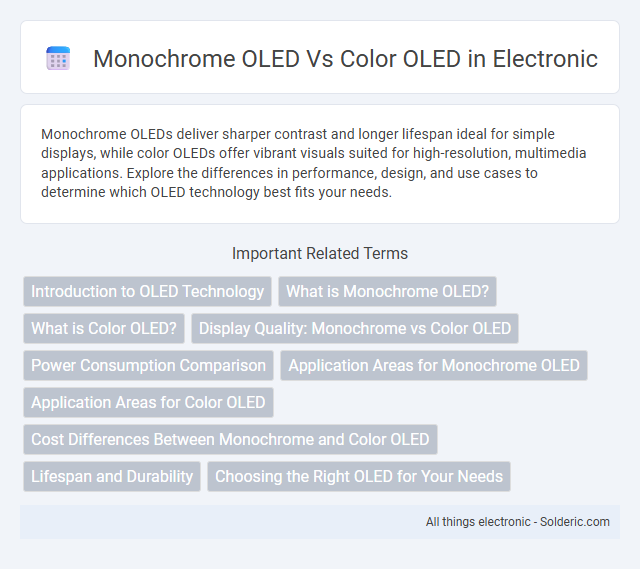Monochrome OLEDs deliver sharper contrast and longer lifespan ideal for simple displays, while color OLEDs offer vibrant visuals suited for high-resolution, multimedia applications. Explore the differences in performance, design, and use cases to determine which OLED technology best fits your needs.
Comparison Table
| Feature | Monochrome OLED | Color OLED |
|---|---|---|
| Display Type | Single-color (usually white, green, or blue) | Multi-color (RGB or WRGB pixels) |
| Power Consumption | Lower power usage, energy-efficient | Higher power consumption due to color pixels |
| Image Quality | High contrast, sharp text and graphics | Rich colors, vibrant images and videos |
| Complexity & Cost | Simple design, lower manufacturing cost | Complex structure, higher production cost |
| Lifespan | Longer lifespan, stable brightness | Shorter lifespan, color degradation over time |
| Applications | Wearables, monochrome displays, indicators | Smartphones, TVs, full-color displays |
Introduction to OLED Technology
OLED technology utilizes organic compounds that emit light when an electric current passes through, enabling self-emissive displays without the need for backlighting. Monochrome OLEDs produce images using a single color, often offering higher brightness and longer lifespan due to simpler structure and reduced power consumption. Color OLEDs generate vibrant, full-color images by combining red, green, and blue subpixels, providing enhanced visual experience at the cost of increased complexity and slightly shorter lifespan.
What is Monochrome OLED?
Monochrome OLED displays use organic light-emitting diodes to emit light in a single color, typically white, green, or blue, offering higher contrast and longer lifespan compared to color OLEDs. These displays excel in low power consumption and sharp text readability, making them ideal for devices like smartwatches, e-readers, and industrial instruments. Your choice of a monochrome OLED can enhance battery efficiency and visibility in various lighting conditions.
What is Color OLED?
Color OLED displays use organic light-emitting diodes that emit multiple colors by layering red, green, and blue subpixels, producing vibrant, true-to-life images and videos. Unlike monochrome OLEDs, which show only shades of a single color, color OLEDs enhance user experience with rich hues and superior contrast, making them ideal for smartphones, TVs, and wearable devices. Your choice between these technologies impacts visual clarity, power consumption, and device functionality.
Display Quality: Monochrome vs Color OLED
Monochrome OLED displays excel in sharpness and contrast due to their single-color pixel design, resulting in deeper blacks and higher clarity for text and simple graphics. Color OLED screens provide vibrant, rich hues and a wider color gamut, making them ideal for multimedia content and images that require accurate color representation. Your choice depends on whether you prioritize superior contrast and battery efficiency (Monochrome) or vivid, immersive visuals (Color OLED).
Power Consumption Comparison
Monochrome OLED displays consume significantly less power than color OLEDs due to their simpler pixel structure and absence of color filters, which reduces overall energy usage. Color OLEDs require additional energy to illuminate red, green, and blue subpixels, increasing power consumption, especially at higher brightness levels. This efficiency difference makes monochrome OLEDs ideal for battery-sensitive devices like fitness trackers and e-readers.
Application Areas for Monochrome OLED
Monochrome OLEDs excel in applications requiring high contrast and low power consumption, such as wearable devices, e-readers, and industrial displays. Their simplified pixel structure enhances visibility in various lighting conditions, making them ideal for automotive dashboards and medical instruments. These displays also dominate in monochromatic signage and smart home devices due to their long lifespan and cost-effectiveness.
Application Areas for Color OLED
Color OLED displays are extensively used in smartphones, televisions, and wearable devices, offering vibrant visuals and enhanced user experiences. They support high-resolution video playback, gaming, and augmented reality applications due to their wide color gamut and fast refresh rates. The technology is also gaining traction in automotive dashboards and digital signage, where dynamic and colorful displays improve information clarity and aesthetic appeal.
Cost Differences Between Monochrome and Color OLED
Monochrome OLED displays generally cost less than color OLEDs due to simpler manufacturing processes and lower material requirements. Color OLEDs require additional layers and subpixel arrangements to produce red, green, and blue colors, increasing production complexity and expense. The cost disparity makes monochrome OLEDs more suitable for budget-sensitive applications where full color is not essential.
Lifespan and Durability
Monochrome OLED displays typically offer longer lifespan and improved durability compared to color OLEDs due to simpler pixel structures and reduced organic material degradation. Color OLEDs use additional color filters and multiple organic layers, which accelerate wear and reduce overall longevity. As a result, monochrome OLEDs are preferred in applications requiring extended reliability and consistent performance over time.
Choosing the Right OLED for Your Needs
Monochrome OLED displays offer higher contrast, longer lifespan, and lower power consumption, making them ideal for simple interfaces like smartwatches or industrial devices. Color OLEDs deliver vibrant visuals and rich color depth, perfect for multimedia applications such as smartphones, TVs, and tablets where image quality enhances user experience. Assess your specific application requirements, power constraints, and display complexity to choose the right OLED technology for your needs.
Monochrome OLED vs Color OLED Infographic

 solderic.com
solderic.com